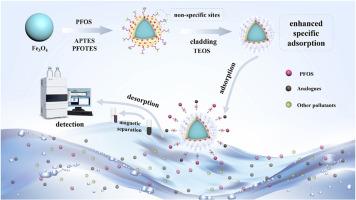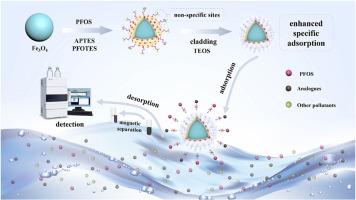磁性纳米材料上定制印迹层和包覆层的制备,增强了对全氟辛烷磺酸的特异性识别
IF 6
2区 化学
Q1 CHEMISTRY, ANALYTICAL
引用次数: 0
摘要
背景全氟辛烷磺酸(PFOS)是一种持久性有机污染物,对生态系统和人类健康具有重大风险。磁性分子印迹聚合物(MIPs)为从污染水中选择性提取全氟辛烷磺酸提供了一种很有前景的解决方案。然而,双功能单体印迹通过引入不同的官能团来提高印迹效果的同时,也会增加非特异性吸附。为了解决这一问题,聚合后采用表面包覆策略,形成惰性包覆层,以减少非特异性结合,提高特异性。结果包层磁性MIPs (Fe3O4@PFOS-cMIPs)的吸附性能明显增强,吸附容量为135.1 mg g-1,印迹因子为3.19,选择性因子大于1.3,超过了目前报道的大多数PFOS-MIPs。通过FTIR分析、zeta电位测量和pH研究,证实Fe3O4@PFOS-cMIPs和PFOS之间的相互作用是静电和疏水相互作用的协同组合。此外,Fe3O4@PFOS-cMIPs具有优异的可重复使用性,在丙酮和NaCl的再生溶液中具有六次稳定的吸附-解吸循环。此外,当与LC-MS相结合时,Fe3O4@PFOS-cMIPs成功地检测了复杂环境水样中的痕量全氟辛烷磺酸。该方法精密度高(RSD为6.0%),回收率高(90.9% ~ 103.3%),检出限低(LOD为0.06 ng L-1),富集因子为299。意义本研究为开发具有增强分子识别能力的磁性MIPs提供了一种实用高效的策略。增强的特异性和吸附能力突出了这些MIPs在从各种污染水源中靶向提取全氟辛烷磺酸方面的强大潜力,为环境分析和修复提供了重要贡献。本文章由计算机程序翻译,如有差异,请以英文原文为准。


Fabrication of tailored imprinted layer and cladded layer on magnetic nanomaterials with enhanced specificity for recognition of PFOS
Background
Perfluorooctane sulfonate (PFOS) is a persistent organic pollutant with significant risks to ecosystems and human health. Magnetic molecularly imprinted polymers (MIPs) provide a promising solution for selectively extracting PFOS from contaminated water. However, while bifunctional monomer imprinting improves the imprinting effect by introducing diverse functional groups, it can also increase non-specific adsorption. To address this problem, a surface cladding strategy was applied after polymerization, forming an inert cladding layer to reduce non-specific binding and improve specificity.
Results
The magnetic MIPs with a cladding layer (Fe3O4@PFOS-cMIPs) exhibited enhanced adsorption performance, achieving a high adsorption capacity of 135.1 mg g−1, an imprinting factor of 3.19, and a selectivity factor greater than 1.3, surpassing most reported PFOS-MIPs. The interactions between Fe3O4@PFOS-cMIPs and PFOS were confirmed to be a synergistic combination of electrostatic and hydrophobic interactions, as evidenced by FTIR analysis, zeta potential measurements, and pH studies. Additionally, Fe3O4@PFOS-cMIPs demonstrated excellent reusability, with stable performance across six adsorption-desorption cycles using a regeneration solution of acetone and NaCl. Furthermore, when coupled with LC-MS, Fe3O4@PFOS-cMIPs successfully detected trace levels of PFOS in complex environmental water samples. The method demonstrated high precision (RSD, 6.0 %), excellent recoveries (90.9 %–103.3 %), a low limit of detection (LOD, 0.06 ng L−1), and an enrichment factor of 299.
Significance
This study presents a practical and efficient strategy for developing magnetic MIPs with enhanced molecular recognition. The enhanced specificity and adsorption capacity highlight the strong potential of these MIPs for the targeted extraction of PFOS from various contaminated water sources, offering significant contributions to environmental analysis and remediation.
求助全文
通过发布文献求助,成功后即可免费获取论文全文。
去求助
来源期刊

Analytica Chimica Acta
化学-分析化学
CiteScore
10.40
自引率
6.50%
发文量
1081
审稿时长
38 days
期刊介绍:
Analytica Chimica Acta has an open access mirror journal Analytica Chimica Acta: X, sharing the same aims and scope, editorial team, submission system and rigorous peer review.
Analytica Chimica Acta provides a forum for the rapid publication of original research, and critical, comprehensive reviews dealing with all aspects of fundamental and applied modern analytical chemistry. The journal welcomes the submission of research papers which report studies concerning the development of new and significant analytical methodologies. In determining the suitability of submitted articles for publication, particular scrutiny will be placed on the degree of novelty and impact of the research and the extent to which it adds to the existing body of knowledge in analytical chemistry.
 求助内容:
求助内容: 应助结果提醒方式:
应助结果提醒方式:


